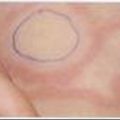11.2 Anaemia
Introduction
Anaemia is not a single disease, but may occur as a result of a variety of pathological processes. The anaemias of childhood can be usefully divided into two groups: (1) those caused by inadequate production of RBC or haemoglobin; and (2) those due to increased destruction or loss of RBC. Tables 11.2.1 and 11.2.2 outline the major causes of childhood and neonatal anaemias.
Overview
The principles of management of anaemia in the emergency department (ED) are:
Initial assessment is directed at respiration and circulation. The anaemic patient may be tachypnoeic with tissue hypoxia. The adequacy of ventilation should be ascertained and supplemental oxygen provided. Circulatory compromise in acute haemorrhage and acute haemolysis requires cardiorespiratory monitoring and intravenous access for fluid resuscitation (see Chapter 2.5 on shock). Packed red blood cells are used if haemorrhage or haemolysis is life threatening. If tissue oxygenation is not critically affected, the circulatory volume should be sustained with colloid or crystalloid until group-specific or cross-matched RBCs are available. If the bleeding is controlled, with further bleeding unlikely, the signs mentioned above are stable and the haemoglobin concentration is greater than 70 g L–1, a cross-match should be performed and the packed RBCs should be held in reserve for 24 hours. Early consultation with a haematologist is important in acute haemolytic anaemia especially if the underlying cause has not been diagnosed.
Patient factors to note are age, ethnicity and the presence of other significant disease. Iron-deficiency anaemia is uncommon in the first 6 months in term infants and sickle cell disease (SCD) is unlikely to present as anaemia under the age of 4 months. Haemolytic uraemic syndrome (HUS) mainly affects those under 4 years of age, whereas thrombotic thrombocytopenic purpura (TTP) affects children from 10 years of age. Iron deficiency is common in adolescent females, whereas G6PD deficiency occurs mainly in males. The association between ethnicity and various types of hereditary anaemia is shown in Table 11.2.3. Family history of anaemia may also suggest hereditary anaemia.
Anaemia is confirmed by the lowered haemoglobin concentration and decreased RBC count. An age-related reference range must be used. Abnormalities in the other cell lines should be noted. The mean cell volume (MCV) may suggest an underlying cause. The upper limit of normal in adults is 96 fL but MCV in children is less than in adults and average values may be estimated by adding 0.6 fL per year of age to 84 fl. The reticulocyte count is expressed as a percentage of the circulating RBC mass with a normal range of 0.5–1.5%. A low reticulocyte count is found in abnormalities of RBC production and a high reticulocyte count is found in increased destruction or from RBC loss, provided there is no concurrent bone-marrow pathology. Morphological features of RBC may be diagnostic of the underlying cause as shown in Table 11.2.4.
| Schistocytes | Erythrocyte fragmentation syndromes |
| Sickle cells | Sickle cell disease |
| Spherocytes | Immune-meditated haemolytic anaemia Hereditary spherocytosis |
| Blister or bite cells with poikilocytosis | G6P deficiency |
Anaemias of childhood
Haemolytic anaemias
The haemolytic anaemias of childhood may be classified as hereditary or acquired (Table 11.2.1). The hereditary haemolytic anaemias are caused by inherited traits that lead to abnormal haemoglobin chains (haemoglobinopathies), abnormal RBC membranes or abnormal RBC enzymes (enzymopathies). The acquired haemolytic anaemias may be immune or non-immune or as a result of fragmentation syndromes.
Non-immune haemolytic anaemia
Erythrocyte fragmentation syndromes
Acknowledgement
The contribution of Marian Lee as author in the first edition is hereby acknowledged.
Chang T.T. Transfusion therapy in critically ill children. Pediatr Neonatol. 2008;49(2):5-12.
Gera T., Sachdev H.P., Nestel P., Sachdev S.S. Effect of iron supplementation on haemoglobin response in children: systematic review of randomised controlled trials. J Pediatr Gastroenterol Nutr. 2007;44(4):468-486.
Kleigman R., Behrman R., Jenson H., Stanton B. Nelson’s Textbook of Pediatrics, 18th ed, Philadelphia: Saunders Elsevier, 2007.
Richardson M. Microcytic anemia. Pediatr Rev. 2007;28(4):151.






